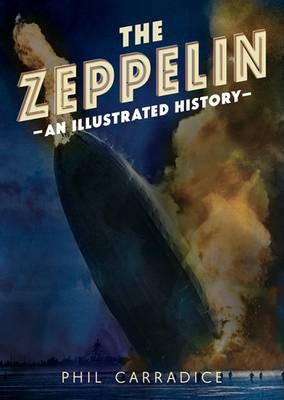
The Zeppelin
An Illustrated History
Seiten
2016
Fonthill Media Ltd (Verlag)
978-1-78155-505-7 (ISBN)
Fonthill Media Ltd (Verlag)
978-1-78155-505-7 (ISBN)
In the early 20th century the future of air travel seemed to lie with the giant airships of Count von Zeppelin. Zeppelins were used during the First World War and afterwards the 'Graf Zeppelin' and 'Hindenburg' were the height of elegance. The 'Hindenburg' disaster of 1937 proved to be the end of the giant airship as a commercial enterprise.
For a brief period in the early Twentieth Century it seemed as if the future of air travel lay with the giant airships of Count von Zeppelin. The First World War ended that dream, fixed wing aircraft superseding the slow moving and unwieldy airships. As weapons of war the Zeppelins were never truly successful although they did manage to terrify huge numbers of unknowing and naive civilians-perhaps more by imagination than by any practical manifestation of their power. The Zeppelin crews of the First World War spent hours in the air, cold and hungry-and with the prospect of a horrendous death, either by fire or by falling thousands of feet to the ground, ever present. As vehicles of mass destruction the Zeppelins were remarkably ineffective. Their real value, lay in their ability to make silent reconnaissance missions over enemy territory and sea lanes. In the post-war days the public began to realise that airships offered a form of air travel that was comfortable, mostly stable and, sometimes, even luxurious. The 'Graf Zeppelin' and the 'Hindenburg' were the height of elegance.Unfortunately, they had two major defects-they were vulnerable to the elements and, due to the hydrogen that kept them aloft, they were also highly flammable.
The 'Hindenburg' disaster of 1937 effectively spelled the end of the giant airship as a commercial enterprise but for almost half a century these wonderful machines had cruised elegantly through the clouds.
For a brief period in the early Twentieth Century it seemed as if the future of air travel lay with the giant airships of Count von Zeppelin. The First World War ended that dream, fixed wing aircraft superseding the slow moving and unwieldy airships. As weapons of war the Zeppelins were never truly successful although they did manage to terrify huge numbers of unknowing and naive civilians-perhaps more by imagination than by any practical manifestation of their power. The Zeppelin crews of the First World War spent hours in the air, cold and hungry-and with the prospect of a horrendous death, either by fire or by falling thousands of feet to the ground, ever present. As vehicles of mass destruction the Zeppelins were remarkably ineffective. Their real value, lay in their ability to make silent reconnaissance missions over enemy territory and sea lanes. In the post-war days the public began to realise that airships offered a form of air travel that was comfortable, mostly stable and, sometimes, even luxurious. The 'Graf Zeppelin' and the 'Hindenburg' were the height of elegance.Unfortunately, they had two major defects-they were vulnerable to the elements and, due to the hydrogen that kept them aloft, they were also highly flammable.
The 'Hindenburg' disaster of 1937 effectively spelled the end of the giant airship as a commercial enterprise but for almost half a century these wonderful machines had cruised elegantly through the clouds.
Phil Carradice is a poet, novelist and historian. He has written forty-five books, ranging from history and biography to fiction and poetry. Carradice broadcasts regularly on BBC 3 and BBC 4 as well as presenting the BBC Radio Wales history programme The Past Master. Carradice appears occasionally as an expert on The One Show.
| Erscheinungsdatum | 24.01.2016 |
|---|---|
| Verlagsort | Toadsmoor Road |
| Sprache | englisch |
| Themenwelt | Natur / Technik ► Fahrzeuge / Flugzeuge / Schiffe ► Luftfahrt / Raumfahrt |
| Geschichte ► Allgemeine Geschichte ► Neuzeit (bis 1918) | |
| Geschichte ► Allgemeine Geschichte ► 1918 bis 1945 | |
| Geschichte ► Teilgebiete der Geschichte ► Technikgeschichte | |
| Technik ► Fahrzeugbau / Schiffbau | |
| ISBN-10 | 1-78155-505-2 / 1781555052 |
| ISBN-13 | 978-1-78155-505-7 / 9781781555057 |
| Zustand | Neuware |
| Haben Sie eine Frage zum Produkt? |
Mehr entdecken
aus dem Bereich
aus dem Bereich
das Grundwissen zur Privatpilotenlizenz
Buch | Hardcover (2024)
Motorbuch Verlag
CHF 55,90


